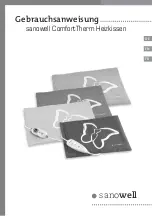
7
Congratulations on your new Veria product!
By following the installation guidelines below you are guaranteed a high-performing result and many years of troublefree use.
1
Let’s get started
A. Necessary tools: Hammer, chisel, pencil, tape measure, craft knife, multimeter, insulation tester and this guidance leaflet and plan.
B. Plan: Draw your room on the graph paper (fig. 2). Remember to draw in any fixed furniture/cupboards etc. and the location of your
thermostat/power supply. The heating mat should not be installed beneath items fixed to the floor, such as cupboards, bathtubs, toilets
etc.
Your Veria Quickmat should have a smaller m² measurement than the available floor area. Any “excess” floor area (without floor
heating) is spread along the walls. Draw in your Veria Quickmat (w: 48 cm) with a gap of 2 cm between the lines on the plan.
Note that the adhesive backing mat under the heating cable can be cut by changing the direction on the layout plan (fig. 3).
C. Transfer your plan with its markings onto the floor, so that you know exactly where you will start and finish.
2
Test your Veria Quickmat
Before you lay the heating mat you must check that the heating conductors works properly.
The resistance value is measured using a multimeter between the blue and black sections (fig. 4a). Check that the value measured
matches the value of the label attached to the cold tail connection. The value displayed must lie within -5% - +10% of the given ohm value.
Make a note of the value measured on the proof of warranty.
Then measure the insulation value with an insulation tester by measuring between the screen (outer connector wiring) and both the black
and blue sections (fig. 4b). The measured value must be over 10 MΩ. If this is the case tick the field on the proof of warranty.
3
Preparation and cleaning
Power supply and floor sensor
Start by cutting/drilling a groove in the wall and floor from the connection point. A separate tube for the thermostat’s floor sensor and the
heating mat’s power cables is fitted into this groove (fig. 5).
Make sure that the groove for the floor sensor stretches at least 50 cm out into the room and that the sensor is placed between two heating
cables. The curve of the tube must have a radius of no less than 6 cm.
Before you fit the cable mat you must prepare the floor surface (fig. 6)
A. Make sure that loose items and sharp edges are removed and that the floor is vacuum-cleaned or washed.
B. For improved adhesion of the heating mat it is strongly recommended that the floor be primed before installation.
This must be done after the cleaning has been completed.
4
Fitting
Fitting the mat
Start by removing the protective plastic foil from the mat. Start rolling it out (with the self-adhesive side towards the floor), referring to
your layout plan.
Place the start of the mat close to the electricity installation/desired thermostat location (fig. 7).
Note that the connections between
the yellow heating cable and the power cable must be embedded.
Spread out the heating mat in the room, referring to your layout plan. When you meet an obstacle (walls, cupboards, toilets or similar),
cut the adhesive backing mat (
not the heating cable!
) and continue in a new direction (fig. 8a-8b).
If the cable, due to installation purpose, has been detached from the adhesive backing mat it can be glued to the underlay using a glue
gun.
5
Midway test
After laying out the mat please measure the resistance value in the mat again (fig. 4a-4b). Use the same procedure as in section 2
– then make a note of the values on the proof of warranty.
Installation guide
EN

























